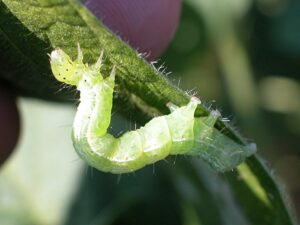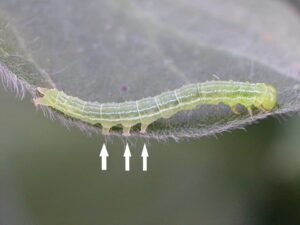I’ve received several calls about looper numbers increasing in soybeans across West Tennessee. Numbers range from 3 per 25 sweeps to 25 per 25 sweeps. Treatment is recommended when defoliation exceeds 20% from R1 to R6 or if looper numbers exceed 19 per 25 sweeps. It’s often suggested to ignore small worms (<1/2 inch) in these counts due to predators and entomopathogens taking a substantial toll on their survival.
Pyrethroid additions, at R3 fungicide timing, can exacerbate looper numbers and shouldn’t be included unless they are needed. This is one of the reasons I caution against including an automatic pyrethroid with fungicides at R3 and those applications won’t have any measurable impact on stink bug numbers when the beans hit R5. Loopers are one of the top pests encountered in late planted soybeans and are the most expensive to control. Further, I received word from my colleagues in Mississippi that low rates of diamides (1.2 fl oz/a Vantacor, 7.0 fl oz/a Besiege, 14.0 fl oz/a Prevathon) are providing unacceptable levels of control in large populations of loopers. This isn’t a surprise but take caution when utilizing diamides. Reports of diamide slippage on loopers has occurred for several years and more often than not, it occurs when low rates are utilized against high numbers (>1.5X threshold). Another product, Intrepid 2F (methoxyfenozide), has also had some control issues in Arkansas and Mississippi. Rates of 4.0 and 6.0 fl oz/a did not provide satisfactory control of loopers 7 days after application; however, Intrepid Edge (methoxyfenozide + spinetoram) performed very well. We have several insecticide options available at our disposal but if you’re facing large numbers, low rates of any product (especially the diamides) probably won’t cut it.
One final comment, don’t confuse soybean loopers with green cloverworms. Loopers have 2 pairs of prolegs cloverworms have 3 (see images below). Cloverworms are much easier to control than loopers and pyrethroids, as well as other insecticides, work well. Information on insecticide options for loopers can be found here: https://guide.utcrops.com/soybean/soybean-insect-guide/soybean-looper/



